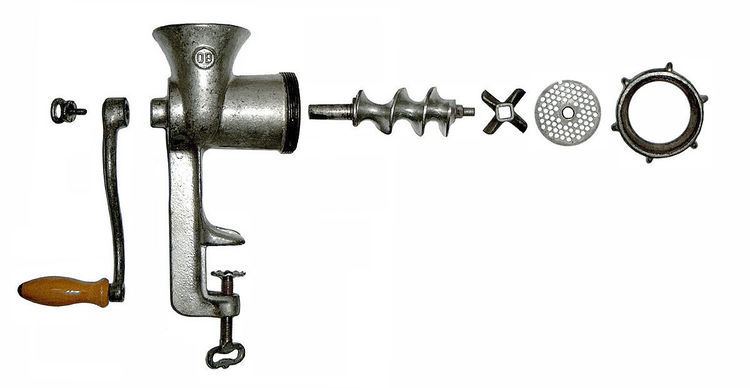 | ||
A meat grinder or meat mincer is a kitchen appliance for fine chopping ('mincing') or mixing of raw or cooked meat, fish, vegetables or similar food. It replaces tools like the mincing knife, for example, which is also used to produce minced meat, filling, etc. The producer puts the minced food into a funnel, which is placed on the top of the grinder. From there the material goes on a horizontal screw conveyor. This screw conveyor, which can be powered by a hand wheel or an electric motor, squashes and partially mixes the food. At the end of the screw, conveyor there is a knife installed directly in front of the fixed hole plate. At this opening the minced meat comes out of the machine. The fineness of the meat depends on the size of the holes of the plate.
Contents
By changing the hole plate it is also possible to produce breadcrumbs or fill sausage casing. After the drop from the retainer, it is possible to change the hole plate. By removing the fixing screw the grinder can be disassembled completely for cleaning. Besides the domestic manually or motor operated grinders, there are also grinders for butchery (table- or shop-grinders for example) and for the food industry. Some large machines are able to produce several tons per hour.
History
The first meat grinder was invented in the nineteenth century by a German revolutionist, Karl Friedrich Christian Ludwig Freiherr Drais von Sauerbronn, also known as Karl Drais.
The earliest form of the meat grinder was hand cranked and forced meat into a metal plate which had several small holes, resulting in long, thin strands of meat. As time passed, the hand-cranked machines became powered by electricity.
The electric meat grinders we now know today can process several pounds of meat easily and uniformly. Current models of electric meat grinders have different attachments, such as sausage, kebbe, and juicing attachments which have greatly broadened the way meat grinders are used.
Mixer unit
A basic optional feature for larger grinders is the mixer unit. With this unit can be mixed different kinds of meat (for example beef or pork) with each other homogeneously and/or can be mixed the meat with additives, like salt or spices, before grinding it. Without such a mixer unit, the additives must be mixed into the meat after grinding it, which adversely affects the taste and appearance of most products.
Frozen meat grinder
Frozen meat grinders can process frozen blocks of meat, bacon and mechanically separated meat down to –25 °C. The frozen blocks can range from 90x50x15 cm to 90x50x20 cm, and the power applied from 8.000 kg to 12.000 kg. By the regular cutting the chopped meat can be processed through mixers and grinders, which reach an optimal addition in the cutter as well as a protection of the cutter and knives.
There are 2 different drive forms, a single rev-drive, which is ideal to grind frozen meat blocks, and a two rev-drive, which promises higher power by the application of a special meat worm.
The first cut takes place in the worm, who peels with his long pulled, sharpen meander/bend approximately 8 cm from the frozen meat and then to pass on for the next cut in the cutting set. The lock protection prevents possible mechanical damages in too high burden/load, for example by a foreign body.
